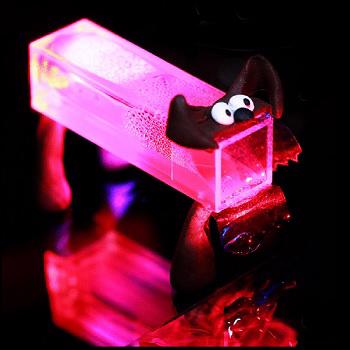Dec 6 2019
Researchers from Aalto University have trained a specially conditioned liquid crystal polymer the same way as Pavlov trained dogs. It could be controlled with the power of light alone, with new potential applications in soft robotics and adaptive material.

Training Liquid Crystal Polymer to Move
Conditioning is a method made famous by Ivan Pavlov’s experiments with dogs. Pavlov trained a dog by ringing a bell every time the dog was fed. The dog learned to associate the bell with food, and then drooled when it heard the bell ring, even if it didn’t see anything to eat. In an earlier study, researchers at Aalto University and Tampere University succeeded in conditioning a solid gel so that it melted to become liquid under the influence of light alone. Now, the same researchers have taught a liquid crystal polymer to move, and to stick to an object of a given color.
“At first, the liquid crystal polymer did not react to light at all, but during the process, it learned to move and grab objects under the guidance of light. The idea is the same as in the previous study, but now the conditioning includes tangible functions”, Professor Olli Ikkala from Aalto University explained.
The plastic used in the study contains liquid crystal molecules whose positioning relative to one another is important for flexibility and transformation.
‘Conditioning’ Teaches New Tricks
“Conditioning can teach materials new tricks, such as recognizing colors or moving in conditions where they don’t originally move,” said Professor Arri Priimägi from Tampere University.
“For material to learn, it must have a memory. When the material is heated, the dye originally spread on the surface of the liquid crystal polymer penetrates the material, thus forming the memory. Different dyes react to different wavelengths of light, so the initially neutral stimulus (color of light) can be controlled by the dye applied onto it. Additionally, when designing the material, molecules must be positioned so that the material reacts as desired when heated,” Olli Ikkala said.
Applications in Soft Robotics and Adaptive Materials
Soft robots copy nature and the human body. “If you give a typical mechanical robot a strawberry it might crush it. So, we need robots that can grasp things very softly. Traditional robots also often need a power cord or a large, heavy battery. Soft robotics aims at lightweight, external control, for example by using light,” said Olli Ikkala.
According to Olli Ikkala, new kinds of materials with the ability to “learn” can be useful in soft robotics already now, even though the functions are still limited.
Arri Priimägi’s team has specialized in soft robotics research for a few years now. According to Priimägi, this research can also open new opportunities in materials technology. It may be possible in the future to create coating materials that change their function under different conditions.
“The concept of conditioning is not only tied to this experimental setting but can be extended to other areas as well. But now, conditioning is only achieved through the combined effect of light and heat,” Priimägi said.
Further Investigations to Condition Completely Independent Signals
Next, the researchers want to determine whether the materials can also be conditioned with completely independent signals. Light and heat are not completely independent because light also produces heat.
“Since functional materials can be controlled by a variety of other stimuli, such as electric and magnetic fields, humidity changes, or chemicals, in addition to light and heat, there are many alternatives to further developing this concept. The material must also have a memory which is activated by a signal,” Arri Priimägi said.
Light robot